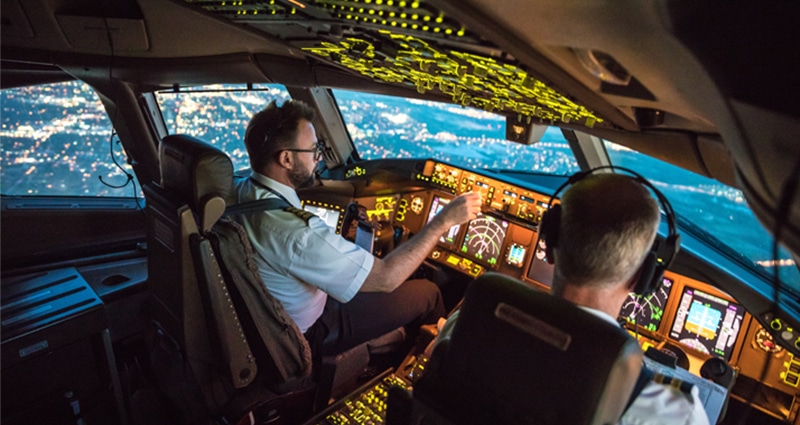Why is it ALWAYS the Pilot’s Fault?

Read any given NTSB accident investigation and you will find that the pilot is at least partially responsible for the accident. If it is not the pilot’s stick and rudder skills, it’s the pilot’s decision-making prior to or during the flight that is identified as the cause, or a contributing factor. The pilot rarely escapes some of the blame and, unfortunately, rightfully so! Pilots need to come together to collectively—and individually—address the ‘human in the loop.’
An area where human factors are repeatedly identified as contributing to the accident is in Loss of Control Inflight (LOC-I). Every four days, a fatal accident occurs due to LOC-I.1 The statistics are staggering and although each incident could likely result from one or more primary causes of LOC-I—environmental, systems anomalies, and human factors—they almost all include contributing errors made by the flight crew.
As pilots, our collective reaction is often denial. Certainly we are not the issue? Other pilots make those types of NTSB-noteworthy mistakes. It is their poor reaction to a system anomaly or their carelessness that led to flight into a convective front that put them in a position where they are left with very few options. However, the reality is that there is a human factor to almost every aviation accident, and we need to address it.
Questions We Must Ask Ourselves Before Every Flight
There are three simple questions that we must ask ourselves before every flight that can help effectively manage and mitigate the potential for degraded cognitive ability of the ‘human in the loop’:
- Did you sleep for eight hours?
- Are you hydrated?
- How do you feel overall?
Early in my flying career I was working with a new pilot just prior to his Navy aircraft carrier qualifications. Let’s call that pilot ‘Blaze.’ Aircraft carrier qualifications are just that: new pilots landing on the aircraft carrier for the first time. In our story, it was in an F-14 Tomcat. Carrier qualifications require very significant practice time dedicated to the landing pattern. Each new pilot flies literally hundreds of ‘passes’ at a practice field, day and night, before ever going to the actual ship. The field does not move, pitch, or roll, so overall it is generally a more peaceful experience.
Every time someone mentions human factors, I think of this one flight. It was an otherwise beautiful day and we were making the base-to-final turn when Blaze announced that he did not have his normal digital cues required to make a successful landing on the carrier. I queried him on the status of the landing gear and, almost magically, his digital cues appeared and his landing systems were now in a GO status (largely because the landing gear was now extended).
I had previously flown hundreds of passes with Blaze without any issues. I was certain this would just be another day of practice until it wasn’t. At 500 feet, 30 degrees angle of bank, on final approach with the gear up. In the debrief, Blaze quickly told me how he hadn’t gotten much sleep the night before, hadn’t had any water that day, and was exhausted. Blaze was officially off his game with regard to those three simple questions before we ever took off, and had failed to address his physiological status with me, his instructor.
The Effect of Lack of Sleep and Dehydration on Pilot Performance
A pilot fatigue study conducted in 2012 still proves true today. John Caldwell confirmed that, “The combination of insufficient sleep and circadian factors is at the heart of the fatigue problem in any operational context.” He later goes on to say, “As a society, we must come to grips with the fact that the average adult needs 7-9 hours of sleep every single day… and there is no amount of willpower, professionalism, training, or money that will prevent the performance losses associated with the failure to routinely acquire sufficient sleep.“2 Each pilot needs to take responsibility for a sleep schedule that meets their flight schedule, and to understand the debilitating effects of lack of sleep on performance.
There are any number of studies that all corroborate the linkage between hydration and performance. In young and old, independent of gender or physical fitness, dehydration has a direct negative effect on cognitive function and other performance metrics, especially during times of stress. “Being dehydrated impairs performance in tasks that require attention, psychomotor, and immediate memory skills, as well as assessment of the subjective state.”3 Those are the very skills that we, as pilots, rely on most, especially during an airborne emergency. In this day and age, even drinking water seems to take too much time. Really? Medical recommendations for daily water intake range around 12-15 cups for men and 10-12 for women, but all recommend drinking enough to keep one’s urine clear.4 Sounds like good advice if it keeps our cognitive function at its peak and eliminates fatigue.
Howgoesit?
The last significant consideration that every pilot should assess before each flight is an overarching ‘howgoesit’ regarding overall physical, mental, and emotional well-being. It is rare indeed that you will have no complaints in any of these areas, but your awareness of them ahead of your flight, and your careful and considered mitigation of them is critical to a safe evolution. You are responsible for a highly complex task while flying, and anything that reduces your substantial skill as a pilot may end up reading as a ‘contributing factor’ in an accident investigation. There are several available checklists that address human factor risk, and provide methodologies for mitigating that risk, including IM SAFE (Illness, Medication, Stress, Alcohol, Fatigue, Eating)5 and others. But only if you take the time to consider and address them will you remain at your peak piloting performance.
“Aviation in itself is not inherently dangerous. But to an even greater degree than the sea, it is terribly unforgiving of any carelessness, incapacity or neglect.”6 We have all heard this quote at some point over the years. Every pilot has a responsibility to help eliminate carelessness, incapacity and neglect—the human factor—from aircraft accidents.
Resources
1 Federal Aviation Administration. Fly Safe: Prevent Loss of Control Accidents. Retrieved July 31, 2017 from https://www.faa.gov/news/updates/?newsId=88467
2 Association for Psychological Science. (2012, April 24). Crew schedules, sleep deprivation, and aviation performance. ScienceDaily. Retrieved July 31, 2017 from http://www.sciencedaily.com/releases/2012/04/120424162336.htm
3 Journal of American College of Nutrition. Cognitive Performance and Dehydration. Retrieved August 3, 2017 from https://www.ncbi.nlm.nih.gov/pubmed/22855911
4 Aviation Medicine. (2014, February). Dry and High. Retrieved July 31, 2017 from http://www.aviationmedicine.com/wp-content/uploads/2014/02/Dry-and-High.pdf
5 Federal Aviation Administration. FAA Fact Sheet. Retrieved July 31, 2017 from https://www.faa.gov/licenses_certificates/medical_certification/media/impairingmedications.pdf
6 Quote from Captain A. G. Lamplugh, British Aviation Insurance Group, London. Retrieved from https://criticaluncertainties.com/2015/01/22/thought-for-the-day/

Prevailance Aerospace is a UPRT provider that has been working with corporate, government, and general aviation pilots to improve safety in the aviation industry. Prevailance Aerospace uses Extra 300 Series Aircraft for training and our pilots are experienced aviation professionals from various military and general aviation backgrounds. We know that successful aviation endeavors are accomplished through an uncompromising commitment to safety, impeccable professionalism, tremendous attention to detail, and constant improvement.
http://prevailanceaerospace.com
© 2024 Prevailance Aerospace. All Rights Reserved.
Next ArticleRelated Posts

Peer Support Programs: Transforming How Aviation Addresses Mental Health
While the industry has evolved in acknowledging these issues, stigma still impedes many from seeking available resources. Here, the significance of Peer Support Programs (PSPs) has been increasingly recognized. These initiatives offer a confidential haven where concerns can be openly discussed, free from judgment.

How High Demand Can Lead to Decreased Professionalism
It’s a good time to be an aviation professional. Demand is high, and supply is low. Options are many. Wages are up. For the first time in years, professionals in the aviation industry have the upper hand. But there is a dark underbelly to these good times.

